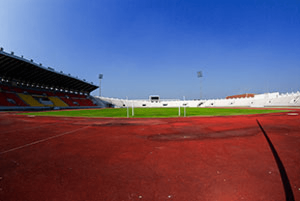 Within our ever-evolving modern society, both professional sports and the environment play equally important, yet quite different roles. From afar, these two subjects are bound by few common threads. But as dissimilar as they appear, both sports and the environment occasionally cross paths, converging at the stadiums and arenas that house the games and matches that millions annually attend. These sporting venues are impressive structures, able to accommodate tens of thousands of fans who gather to collectively support their favorite team. Just as sports is an important part of our social framework, these venues are equally significant to the framework of sports. However, an unfortunate downside to this convergence of sports and the environment is the excessive waste production and resource depletion that occurs within and around these venues, and the substantial impacts that this has on the surrounding environment.
Within our ever-evolving modern society, both professional sports and the environment play equally important, yet quite different roles. From afar, these two subjects are bound by few common threads. But as dissimilar as they appear, both sports and the environment occasionally cross paths, converging at the stadiums and arenas that house the games and matches that millions annually attend. These sporting venues are impressive structures, able to accommodate tens of thousands of fans who gather to collectively support their favorite team. Just as sports is an important part of our social framework, these venues are equally significant to the framework of sports. However, an unfortunate downside to this convergence of sports and the environment is the excessive waste production and resource depletion that occurs within and around these venues, and the substantial impacts that this has on the surrounding environment.
During a typical sporting event, one of these venues can serve as the gathering point for upwards of 80,000 fans – a population that, albeit temporary, rivals that of an average city. And much like an average city, these venues are faced with environmental problems related to waste reduction, resource conservation, and pollution control. Over time, these venues became modern cathedrals devoted to excess, producing wasteful, inefficient, and generally environmentally irresponsible behavior both inside and out. Many of these venues were constructed long before the topic of the environment was part of the popular consciousness, at a time when the belief was that “bigger is always better”.
However, many professional sports organizations are beginning to understand what a few have already embraced – that their responsibility to their city or region goes beyond the product on the field or court. This responsibility is shifting into the realm of social and corporate responsibility, which includes the need to be better environmental stewards. For example, since 2008, Major League Baseball (MLB), has taken a somewhat proactive approach to environmental protection and conservation, collaborating with the Natural Resources Defense  Council (NDRC) to develop the “Team Greening Program,” an environmental initiative that supports and coordinates sustainable practices managed by its individual organizations. This program encourages every MLB team to adopt an official environmental policy, incorporate environmental language into contracts, and use renewable energy. This might explain why some of the most sustainable venues in the American professional sports landscape belong to MLB organizations. AT&T Park, home of the San Francisco Giants, has long been regarded as a benchmark for environmentally friendly venues, recently becoming the first MLB ballpark to receive LEED Silver Certification from the U.S. Green Building Council (USGBC) – the preeminent program for the design, construction, and operation of high-performance green buildings. Five hundred miles to the south, the San Diego Padres’ Petco Park has implemented an array of sustainability features and measures, including an elaborate recycling program that recycles everything from plastics and aluminum to cooking oil and food waste.
Council (NDRC) to develop the “Team Greening Program,” an environmental initiative that supports and coordinates sustainable practices managed by its individual organizations. This program encourages every MLB team to adopt an official environmental policy, incorporate environmental language into contracts, and use renewable energy. This might explain why some of the most sustainable venues in the American professional sports landscape belong to MLB organizations. AT&T Park, home of the San Francisco Giants, has long been regarded as a benchmark for environmentally friendly venues, recently becoming the first MLB ballpark to receive LEED Silver Certification from the U.S. Green Building Council (USGBC) – the preeminent program for the design, construction, and operation of high-performance green buildings. Five hundred miles to the south, the San Diego Padres’ Petco Park has implemented an array of sustainability features and measures, including an elaborate recycling program that recycles everything from plastics and aluminum to cooking oil and food waste.
Of course, MLB is not alone in its desire to incorporate sustainability into the daily operations of its venues. Oversees, European venues playing home to the most popular sport in the world, soccer (or association football, for everyone outside of the States), are no stranger to sustainability, having developed features and measures that promote environmental protection and conservation for years. Almost ten years ago – when the term “sustainability” was still relatively foreign to the masses – Emirates Stadium in London, home to the English Premier League’s Arsenal, joined the fray. The stadium implemented a passive and mixed-mode ventilation system, skylights and glass paneling, and photovoltaic solar power panels into the design of the venue – all of which have measurably reduced the venue’s overall energy consumption. Closer to home, collegiate venues are also embracing the idea of sustainability. In 2009, the University of Minnesota’s TCF Bank Stadium received LEED Silver Certification by using locally sourced steel during construction; recycling a vast majority of construction waste; designing a reflective roof to reduce the heat island effect; and by building a stormwater management system that captures and treats onsite runoff prior to discharge.
As we look towards the future, the relationship between the environment and the world of sports continuous to grow. The FIFA World Cup is one of the largest sporting events in the world, and it’s been known to have a massive carbon footprint. To battle that carbon footprint, FIFA has announced that the 2014 World Cup in Brazil will have a $20 million dollar sustainability budget, and that FIFA plans to make this the first World Cup with a comprehensive sustainability strategy. According to Environmental Leader, this budget is going towards building “green” stadiums, waste management, community support, reducing and offsetting carbon emissions, renewable energy, climate change, and capacity development. FIFA and the Local Organizing Committee will also be jointly producing a comprehensive sustainability report that will be in accordance with the Global Reporting Initiative.
Once a significant drain on precious resources and a substantial contributor to the waste stream, sports venues of all types and sizes have been making measurable strides towards sustainability. So the next time you go to the ballpark to support your hometown team, you can be assured that you’re also supporting mother earth.
If you would like to learn more about sustainability, sustainable practices and how to incorporate them in your workplace, click the link below.





